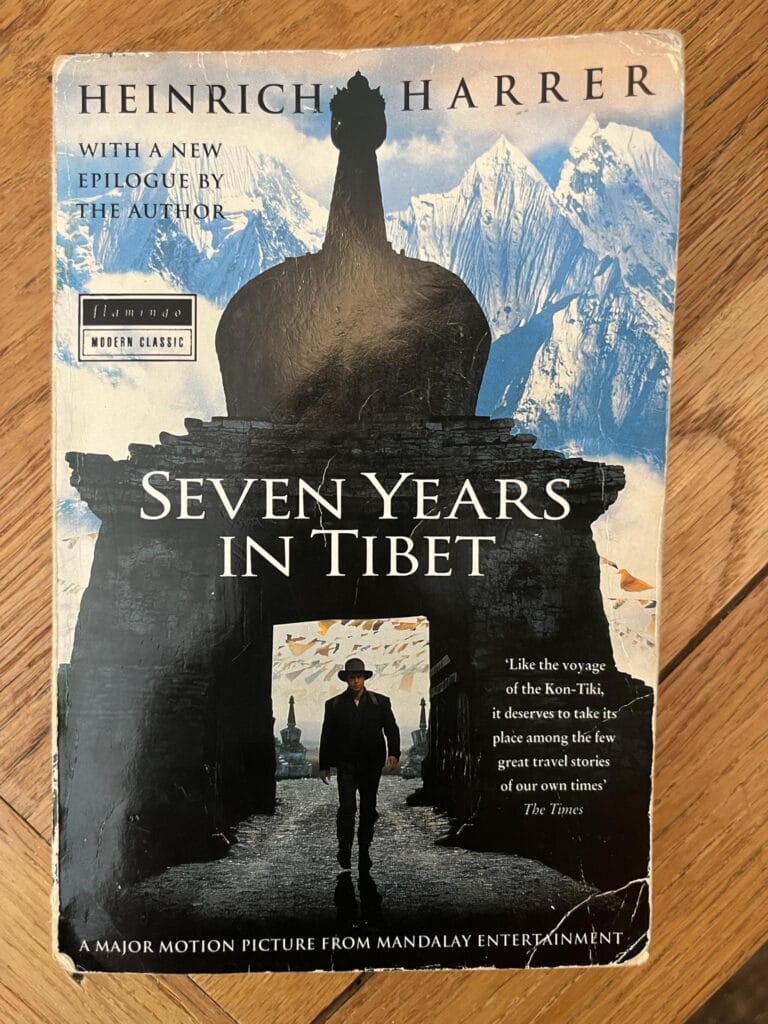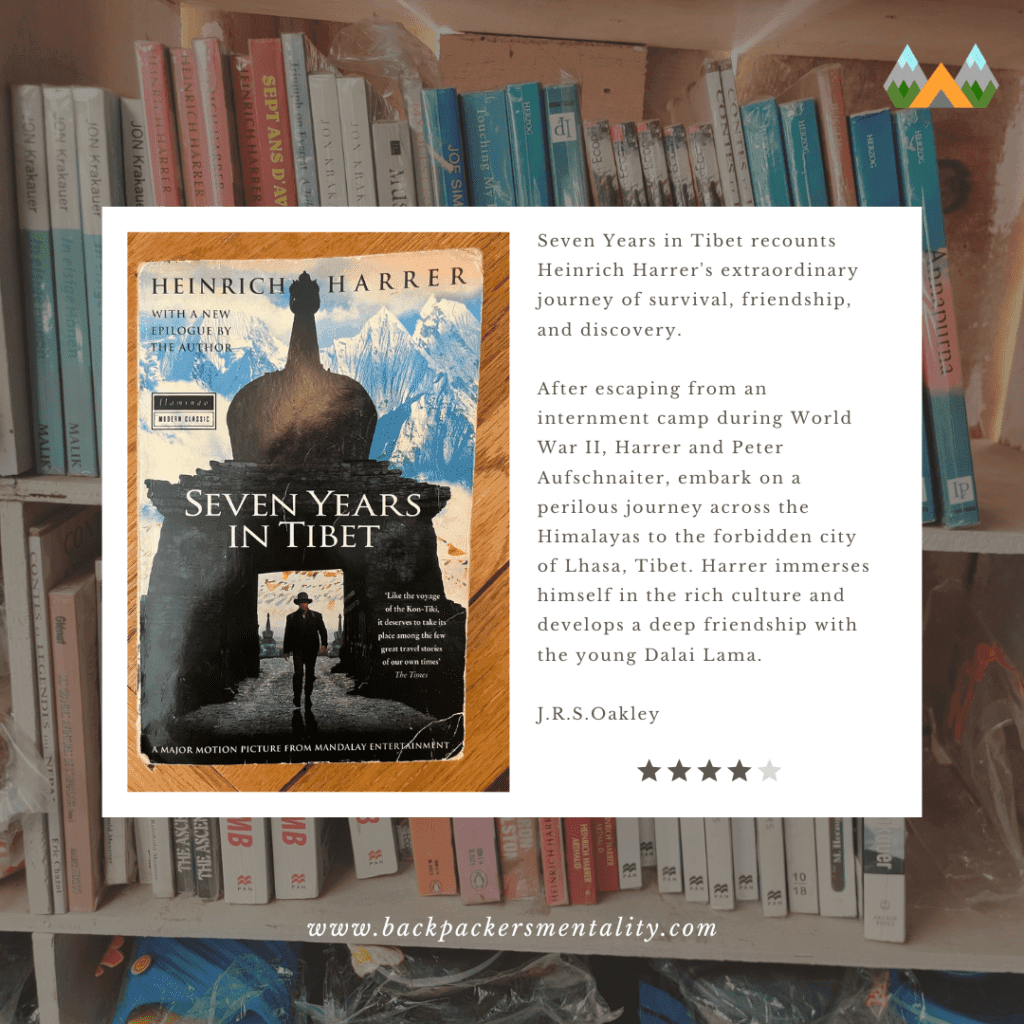Book Review: Seven Years in Tibet by Heinrich Harrer
Overview
Seven Years in Tibet is a classic memoir by Austrian mountaineer Heinrich Harrer, first published in 1952. Set against the backdrop of World War II, the book chronicles Harrer’s escape from a British internment camp in India. And his arduous trek across the Himalayas, ultimately leading him to Lhasa, the capital of Tibet. Harrer’s narrative captures his deep immersion into Tibetan society, highlighting his close relationship with the 14th Dalai Lama, who was a young boy at the time. Through vivid descriptions and keen observations, Harrer documents Tibet’s unique traditions, religious practices, and political atmosphere during a pivotal period before the Chinese annexation. His account provides readers with a rare glimpse of a way of life that would soon undergo dramatic changes, making it both a personal journey of transformation and an invaluable historical record.

Summary
The book is a fascinating blend of adventure, cultural exploration, and philosophical reflection. Harrer’s writing vividly brings to life the breath-taking landscapes of the Himalayas during his escape from captivity in India. He details the warmth and resilience of the Tibetan people, and the unique spirituality of Tibetan Buddhism. His descriptions of Tibetan customs, rituals, and daily life provide an intimate window into Tibet. The forbidden country was largely inaccessible to the outside world. Harrer’s inspiring account of his extraordinary journey of survival started with the escape of the British internment camp in India during World War 2. Then continued the perilous journey across the Himalayas in the hope of being granted residence in Lhasa, Tibet.
One of the most compelling aspects of the memoir is Harrer’s transformation over the course of his stay in Tibet. Initially driven by survival and adventure, his experiences lead him to develop a deep respect and affection for Tibetan culture and its people. From the remote Tibetan Plateau and Himalayas where the danger was significant; to the Forbidden city of Lhasa with it’s strong spiritual and religious practise , the journey was very contrasting. This insight has a lasting legacy as a western traveller having a rare opportunity to document Tibet with it’s rich spiritual and cultural life before the Chinese invasion. His relationship with the Dalai Lama is particularly touching, offering insights into the young leader’s intellect and humanity.
While the book is celebrated for its portrayal of Tibetan culture, it is also worth noting the historical backdrop of Tibet’s looming political struggles, which are subtly woven into Harrer’s narrative. Readers seeking a detailed account of Tibetan geopolitics might find the memoir somewhat lacking, as Harrer focuses primarily on his personal experiences rather than broader historical analysis.
Prevalent Themes
Seven Years in Tibet explores a range of profound themes that resonate deeply with readers. Here are some of the most prominent ones:
- Cultural Exploration and Understanding: The memoir delves into the rich tapestry of Tibetan life, from its customs and traditions to its spiritual and philosophical beliefs. It emphasizes the value of learning from and appreciating cultures different from one’s own.
- Personal Transformation: Heinrich Harrer’s journey is not just physical but also deeply internal. His time in Tibet transforms him from a survival-driven adventurer into someone who gains a profound respect and love for the Tibetan people and their way of life.
- Friendship and Human Connection: The bond between Harrer and the young Dalai Lama is a key highlight, showcasing the power of friendship across cultural and generational divides.
- Spirituality and Simplicity: Tibetan Buddhism and its teachings on peace, compassion, and mindfulness are central to the narrative. The book reflects on how a simpler, more spiritual way of living can lead to fulfilment.
- Resilience and Adaptability: Harrer’s escape from imprisonment and his survival in harsh environments underscore the importance of perseverance and adaptability in overcoming life’s challenges.
- Impermanence and Change: Against the backdrop of Tibet’s political turmoil and its eventual invasion by China, the book subtly touches on the theme of impermanence, reflecting the fragile nature of cultures and societies.
Pros:
- Authentic Cultural Insight: Harrer provides a vivid and detailed account of Tibetan traditions, rituals, and daily life, offering readers a rare glimpse into a culture that was relatively unknown to the Western world.
- Personal Transformation: The narrative reflects Harrer’s own growth, from an ambitious adventurer to someone deeply respectful of Tibetan spirituality and philosophy.
- Historical Significance: His firsthand account of Tibet in the 1940s serves as an invaluable historical record of a time before Chinese occupation altered the region forever.
Cons:
- Colonial Perspective: Harrer’s narrative occasionally carries a colonial lens, reflecting a Western superiority typical of that era, which may feel outdated to modern readers.
- Limited Emotional Depth: While the adventure is compelling, Harrer’s writing at times lacks emotional introspection, focusing more on external events than internal struggles.

Verdict
Seven Years in Tibet is a captivating and insightful memoir that blends adventure, cultural exploration, and history. Though it carries the biases of its time, it remains a valuable and thought-provoking account of one man’s journey through an extraordinary land. Highly recommended for those interested in travel, history, and Eastern spirituality. And there is a blockbuster film starting Brad Pitt released in 1997 (7.1 rating on IMBD) if you fancy watching this amazing story after reading the book. It stands as both an inspiring tale of personal resilience and a poignant tribute to a unique and beautiful culture.
Ratings:
BM Rating: ⭐️⭐️⭐️⭐️☆ (4.0/5)
Goodreads Rating: 4.10 / 5 (25563 Ratings)
Find more Book Reviews and Recommendations on The Bookshelf as well as other useful travel tips.
What is your favourite mountaineering book? I’m always looking to build my book collection.